Dominion Cycle – Pack 1 – Rokugan at War
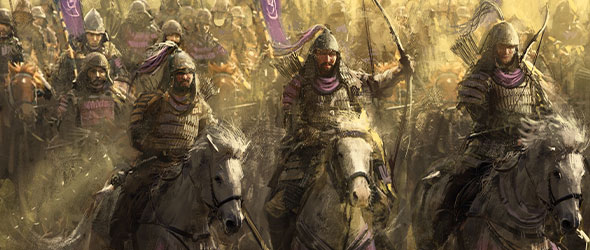
The start of a new cycle is always exciting. Not only do we get a whole new set of cards but we also get new mechanics and this first pack certainly doesn’t disappoint with a lot of new cool toys!

Shrug Off Despair
This void province for Crab has a chunky 6 province strength, but apart from that doesn’t really deliver. To use the ability, you need the province to be revealed. Typically, this means your opponent needs to attack the province, and then you then need to save it. Once the province is revealed and usable, all it does is provide a telegraphed action that moves a conflict into the province again – a province with only 6 province strength and that doesn’t defend itself or negatively impact your opponent. If you can build a huge fortification set around this province, that might pay dividends, but it’s also likely to be far, far too slow.
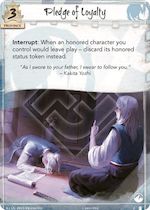
Pledge of Loyalty
To get this Crane earth province online, you need to go through the same steps as Shrug Off Despair, but in this case the effect is a little more desirable. Being able to save a character from dying every turn is pretty great – almost like a reusable Iron Mine! However, as with Shrug Off Despair, Pledge provides no immediate impact and no way to defend itself, and even when it works, its effects will not be felt until the following turn. That said, Pledge can provide devastating value if it shows up early and survives, and could easily tip a game if this happens.

Sharing Shinsei’s Wisdom
This Dragon water province immediately compares to Feast or Famine, due to the fate movement. Sharing Shinsei’s Wisdom is similar, but triggers on reveal instead of break (making it better), but requires the fate be moved between characters controlled by the same player (which is worse). So you end up with two scenarios here: Either you move fate from your small guy to your big guy, or from your opponent’s big guy to their small guy. It’s a benefit that’s mostly going to pay off later in the game, which makes early reveals of this highly undesirable. And you also may not have suitable targets for it to trigger effectively at any stage of the game, but especially early, where there might only be a character on each side. That said, this is a water province, so its main competition is Rally to the Cause or Midnight Revels, and not every deck enjoys those two provinces. So, even if Sharing isn’t a great option, it may be a slightly better one for certain builds.

Ninkatoshi
We talked about the difficulties of getting some of the earlier provinces revealed and ‘online’. This province is the first example of the new Eminent keyword, which means the province starts face up at the start of the game. The Eminent provinces in this set all have two elements, which means they can be run as either element, making them more flexible. They are not good for Seeker roles, however, since the province starts revealed. We’ve seen Eminent-style provinces before with the Scorpion province Toshi Ranbo, so we’ve had some time to judge their merits. The main advantage is having an additional ability available at the start of the game, but the drawback is giving your opponent information. Information is a valuable commodity in L5R, so the payoff needs to be worth it. Unfortunately, the ability on this province is pretty low impact. If you’re going first, it makes it slightly easier to break a province, but it provides your opponent with safe province to attack into, which does not help defend itself in any way. Ultimately, running this province probably gives more advantage to your opponent than it does to yourself.

Kakudaira
Another Eminent province and this time for the Phoenix. The effect is underwhelming. Normally you only care if cards are face up during the dynasty phase, since that’s when you play them, but there are some exceptions to this, including Keeper Initiates, holdings, and cards with Rally (the first example of which comes later in this pack). If this card said ‘reveal each facedown card in all your provinces’ it might be worth consideration, but since it only reveals its own card, the chances of gaining any advantage form it are vanishingly low.

City of the Rich Frog
A few players have recommended I get at least a second copy of this pack, and this is one of the reasons. As an Eminent province, City of the Rich Frog has all the pros and cons as before, and earth and void are already good province elements – to the point where this is probably replacing an Upholding Authority. CotRF doesn’t defend itself and only has 3 province strength, but it adds 50% to the potential number of dynasty cards you have access to every turn, and that can be massively impactful. It makes your dynasty deck far more consistent and lets you get to what you need.
Some important things to note: During setup, you look at your 4 dynasty cards and mulligan, then you do your conflict side mulligan, and only after that do you add the extra two cards to City of the Rich Frog. Perhaps most importantly, however, you do not fill this back up to 3 cards every turn. It only fills to 3 if it empties. So, if a single card is left in it, then you get no refill (holdings will be the most likely offenders here).
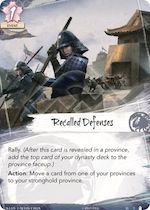
Recalled Defenses
Recalled Defenses gives us two more firsts. Despite being an event, this is actually a dynasty card, so it will appear in a province rather than be drawn from your conflict deck. Dynasty-card events can only be triggered during the dynasty phase, so you don’t get to trigger this during the conflict or other phases. It also has the Rally keyword, so when it is revealed you add an extra card to the province where it appears. This makes cards with the Rally keyword very competitive for deck slots, irrespective of their abilities. Every Rally card in your deck essentially reduces the size of the deck by 1. This is definitely efficient, but it also involves opportunity costs at the level of deck construction, so you should continue to consider each card on its individual merits.
So, apart from Rally, what does Recalled Defenses do? For 1 fate you can move a card from one of your provinces to your stronghold. The obvious option is to move a holding there, keeping it safe, while not clogging up your provinces. If this was a conflict card, you might consider 1 or 2 copies, and would probably cut it before reaching your final 40 cards, but this is a dynasty card with Rally, so the ability is actually more of a bonus.
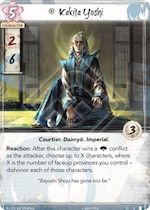
Kakita Yoshi
Seeing a new version of a unique character is always a frustration. It doesn’t matter how good the new character is, either they’re not good enough to replace the old version or they are, so you stop playing the old version. The old version of Kakita Yoshi has been a great asset to the Crane, but his ability is completely reliant on having the Imperial Favor. This version doesn’t have that condition. Instead you need to win a political conflict as the attacker, which, for Crane, shouldn’t be a problem. Once you do, you get to dishonor a number of characters equal to the number of face-up provinces you control. Early game, chances are you only going to have Eminent provinces. Later in the game there’s a good chance you’ll have two or three (probably destroyed but still face up). Dishonoring isn’t a big theme for Crane, they’re more interested in honoring their own characters, but cards like Duel to the Death, For Shame!, and Noble Sacrifice will love having Yoshi around.

Cycle of Rebirth
This is my favourite card of the pack and I immediately put three in my Dragon deck. Whether this is a great idea or a terrible one, I don’t yet know. Again, this is a dynasty event, but unfortunately it doesn’t have Rally. Unlike the other dynasty events we’ve seen so far, this is free, but using an action during the dynasty phase does reduce the chance you’re going to get passing fate. The effect allows you to shuffle this card and another card into their decks, replacing both face up. So this can be used to improve your draw, essentially revealing 2 more cards, or it can shuffle back in one of your opponent’s cards, possibly a holding or their key character.
You can only use one Cycle of Rebirth per turn, so if you reveal more than one in a turn, you don’t get to trigger the second (or any subsequent ones). Since triggering the effect shuffles the card back into your deck, you’re more likely to see one or more appear as the game progresses (assuming you trigger it every turn). While drawing two Cycles in a turn can be alleviated by using one to shuffle in the other, there’s always the chance you’ll end up drawing into another!
There definitely will be scenarios where Cycle will screw over the Dragon player. There will also be games where it lets the Dragon player get a perfect start turn one, and there will be games where a well played Cycle will shut down an opponent’s turn, leaving them with nothing they can play.

Akodo Reserve Company
4 fate for 5 military skill is pretty decent, especially when you consider how well it works with Way of the Lion, but there are already a few cards that have a similar fate-to-skill ratios, and they don’t see much play (Siege Captain, Bayushi Aramoro, Moto Horde, Asahina Takako, Asako Togama, Attendant to the Emperor). However, the Rally effect of Akodo Reserve Company may see them buck this trend, since they provide solid deck filtering with the option of buying a decent character if the situation dictates.
This character’s ability relies on Battlefield, a trait present on some holdings (like Favored Ground and Staging Ground) and also certain attachments that are played on provinces, like Total Warfare. There only needs to be a Battlefield in play, rather than in the current conflict, so it’s a situational requirement, rather than a painful one. If we assume we have one in play, Reserve Company’s ability will then let us pick a character in the conflict, move the Akodo Reserve Company in, and then move the targeted character home. You could also select the Reserve Company if it’s already in the conflict. They don’t get moved in, since they’re there already, and they’ll then get moved home. The movement ability fits in with all the straighten tricks recently added to the Lion’s list of cards, but the ability will rely playing more Battlefields than just Favored Ground.
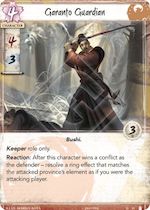
Garanto Guardian
The Phoenix Bushi deck is another one that’s never quite taken off. Garanto Guardian looks pretty good for this deck, but, like the rest of the high-glory bushi, it suffers badly when dishonored. The ability is pretty fun, letting you trigger a ring that matches the defending province’s element if you win, but it doesn’t help you get over the line. Since the Guardian is also limited to Keeper decks, you don’t get to stack the province elements to favour a certain ring. At best, you can use the Eminent provinces with multiple elements to increase your options.
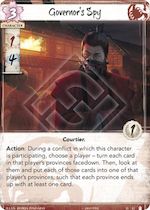
Governor’s Spy
Three cost for a 4 skill character is good value already. Scorpion players might prefer 0 glory to 1, but the Courtier trait is always welcome. The ability, however, isn’t much to look at. It can be used to turn holdings facedown, which can be useful; and it does let you move cards around when a province is about to be destroyed. With City of the Rich Frog in play, you can end up with more cards than provinces, letting you move two cards away from it – and if you had another way to discard that last card in CotRF, then it would refill the 3 again. That could either be a bonus for you or a push to discard your opponent’s cards.
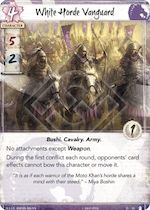
White Horde Vanguard
Another 4-cost character with 5 military, but in this case no Rally. During the first conflict each turn, he is immune to opponents’ bow and movement effects, so he makes a pretty decent tower platform. But you’ll only be able to do it on the attack every second turn.
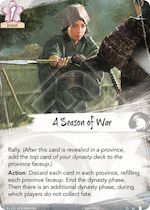
A Season of War
This is a big one. As a neutral Rally card, we can expect to see this in almost every deck. The ability itself has a range of uses. For 1 fate, you can remove your opponent’s holdings, redraw a bad draw for yourself, or a good draw for your opponent. If you use the ability, you’re obviously not going to be able to pass the first time round, but you’ll still have the chance to do so the second time. In a worst-case scenario, your opponent passes before you use the ability, the redraw is bad for you and good for your opponent, and your opponent gets to pass first again! Something to consider when using the card, but right now we recommend 3 in every deck.
This card is noteworthy for Crab players in particular. Not only does it discard holdings, it also messes with Those Who Serve, which sees a lot of play in Crab swarm archetypes right now. If you play Those Who Serve while your opponent has A Season of War in play, they can trigger ASoW to start a new Dynasty phase, wasting your Those Who Serve. So if you’re playing one of those Crab decks, you probably want to play ASoW yourself, so you can discard your opponent’s ASoW!

Our Foe Does Not Wait
Any effect that lets you look through even part of your deck to fetch something deserves consideration. Our Foe Does Not Wait allows you to exchange a conflict attempt to search through, at minimum, 25% of your deck. Although you could fetch a character you want to buy on the following turn, the typical play will probably be to fetch a Kuni Labs, to provide a big skill bump across your board. This is role locked to Earth, but Keeper of Earth is already a fantastic role, and Crab often play it.
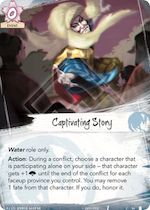
Captivating Story
Political bonuses still are in the minority, so any card that provides one is worth considering. In this instance, early in the game you’re probably only going to get a +1 bonus from an Eminent or recently attacked province. Turn two, it would be reasonable to expect a +2 bonus, which still isn’t great. In the late game, that bonus is going to be bigger, but maybe if this card helped you win some of those earlier conflicts you wouldn’t need it.
There is also a kicker for this card: You may remove 1 fate from a character to honor them. That makes this a pseudo-Court Games with an extra skill bonus. The cost of losing a fate from a character might seem hefty, but Lion’s A Legion of One has been very effective. Captivating Story isn’t quite as aggressive though, and you’re looking for a combination of 6 between your revealed provinces and that character’s glory to match ALoO’s bonus, which is not happening early. In addition, Water isn’t a popular role for Crane right now, but this card might offer a little extra incentive.

Educated Heimin
The idea behind Educated Heimin is kinda neat. Playing this attachment gives you control over your dynasty draw for the following turn(s), so if you have a key dynasty card that you’re trying to get to, you can fish for it. The Heimin will be played before you discard face-up cards during the regroup phase. During discard, you’ll get to look at the top 2 or 4 of your dynasty deck, pick the best option, and discard the rest. Then, at the start of the next turn, you’ll reveal your cards. When attached to City of the Rich Frog, the Heimin will look at two cards for each card refilled, giving you the best three picks from six cards.
In a typical deck, the benefits of this card will be quite subtle. It’s not always going to improve your draw, and a game where it does help is going to be hard to compare to a game where you didn’t need it. Obviously, the Heimin gets better if you have a particular dynasty combo you’re looking for, especially in a deck where discard effects also help, like in holding decks for Crab. Right now, Dragon have little use for the card, and, at 3 influence, it’s not likely to be splashed.
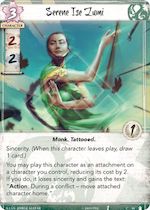
Serene Ise Zumi
At 3 cost for a 2/2 character with 1 glory, this is quite severely over-costed, even with Sincerity. Presumably, you’re paying extra for the flexibility, which in this case lets you play the card as an attachment for 1 fate with no bonuses and an ability that lets you move the attached character home. While have the option to choose between two modes is great, unfortunately, both options really aren’t worth the cost.
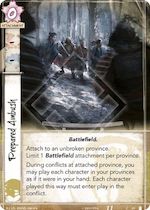
Prepared Ambush
Being able to play a character from your province is an amazing ability, as we’ve learned from the recently banned Hidden Moon Dojo. HMD allowed you to pass first during the dynasty phase; then, during the conflict phase, you were able to react to the board by playing dynasty characters exactly when and where they were needed. Although Prepared Ambush may seem similar in some regards, it really isn’t. You can still pass first during the dynasty phase, which is good. But once a conflict has started, if you play Prepared Ambush, your opponent first has an opportunity to destroy this attachment. Even if they can’t, the ability to purchase characters is limited to that province, so once that conflict is over, Prepared Ambush will not affect any further conflicts, unless the conflict is at the exact same province as before.
So no, this isn’t Hidden Moon Dojo. It’s not even a Daidoji Uji. It has the potential to be a surprise play, but it comes with some pretty big risks.
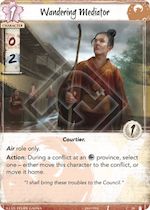
Wandering Mediator
Conflict characters that cost 1 fate are almost always great. That you’re also getting 2 political skill for that makes this character good from the get-go. The 1 glory can also be significant for shifting the glory count for the Imperial Favor. The Courtier trait is highly desirable for a number of actions, like For Shame!, Regal Bearing, and Tattered Missive. Phoenix cards that interact with Courtier include Chikai Order Protector, Righteous Delegate, and Erudite Prestige. In addition, the Expert Mediator’s ability allows you to move him into or out of a conflict at an air province. Moving in can allow this character to participate in two conflicts, perhaps to play an ability like For Shame!, or to avoid the honor loss for an undefended conflict. The ability also allows some trickier plays, like defending, playing some actions, and then moving home to allow the use of Display of Power, which requires no defenders. All of this makes this 1-influence character particulary interesting for Scorpion dishonor builds, who already play Display.
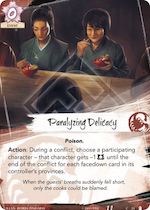
Paralyzing Delicacy
Often you play Banzai! because it cancels your opponent’s Banzai! So an event that can do -4 military is almost as good as one that gives +4 military, especially in a tower meta where characters often have more than 4 military skill. Unfortunately, this is not that event. Sometimes this will be as high as -6, when your opponent has everything facedown and a City of the Rich Frog in play. More often, however, this is going to end up as a -2 or -3 military effect that is just a little too underwhelming. It does help Bayushi Aramoro kill his target and it can be fetched with Shosuro Hametsu, so there might eventually be some applications in a Shinobi deck.
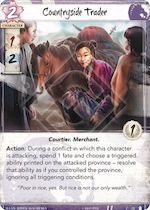
Countryside Trader
Most people play good provinces. If you run into a simple province like Fertile Fields with Countryside Trade you’re getting a card for a fate, which can be a good trade. What really makes this conflict character scary is how it ignores all triggering conditions – which means the abilities of on-reveal and on-break provinces can also be used. Those effects are designed to be more powerful, since they (theoretically) should only trigger once. With Countryside Trader, however, a player could end up triggering The Art of War multiple times (across different turns, or with multiple Traders), drawing 3 cards for 1 fate each time. Obviously, this is something that will depends on the power of the provinces your opponent plays and how those provinces are worded. Definitely a strong consideration for Unicorn and, at 2 influence, should also see play in Unicorn splashes.
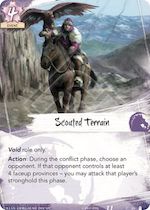
Scouted Terrain
The 4 fate cost of Scouted Terrain is a lot, but being able to skip straight to an opponent’s stronghold province is a big deal. Actually revealing 4 provinces can be tricky, though. With City of the Rich Frog and a few early attacks, you might be able to play this by turn 2. If you do, you’ll need to keep 4 fate in reserve and crucially, not have this event cancelled!
There are two approaches you can take with this. Shiro Shinjo already focuses on revealing provinces to gain extra fate, so this fits into a strategy that’s already being pursued, and in a stronghold that helps you pay the high cost. Alternatively, with Hisu Mori Toride, you can declare more conflicts, revealing 4 provinces sooner. Both have merits. I think it’s likely that Scouted Terrain will fit as a 1-of into an existing deck that can be a surprise option rather than a deck fully dedicated to Scouted Terrain as a primary goal.

Field of Ruin
During the draw phase, you can pay 1 and attach this to a province to discard each card in that province. If played on a province with a holding, it gets rid of the holding. Since this attachment discards cards regardless of whether they are face-up or facedown, this can be used as part of a mill strategy, either on yourself, to get cards into your discard pile, or on your opponent, to push them toward reshuffling and losing 5 honor. This can be particularly effective on City of the Rich Frog, where all 3 cards will get discarded.
If you have any comments or feedback please post them in the comments section below. Check us out on the Imperial Advisor website, podcast, and YouTube channel for more discussion about the L5R LCG.

3 Replies to “Dominion Cycle – Pack 1 – Rokugan at War”
I think you all are significantly underestimating Pledge of Loyalty. Creating huge dueling towers that can defend all conflicts is one of the many things Crane does best. Throw in Talisman to flip it up when you know you can defend it, and protect it when you can’t. And what your comment about big characters usually having fate on them misses is that with a deck built around Pledge you don’t have to do that. You can play out a 3 cost Duelist turn 1 with 1 fate on them and have good odds that you will get to keep them for the rest of the game as they just get more and more attachments that make it impossible for your opponent to do anything. The only saving grace is that you actually have to choose between Toshimoko and Magistrate’s Station.
I also think Scouted Terrain is exactly the finisher Shiro Shinjo needed. One of it’s problems has been that you want to prolong the game but you also are more interested in poking than breaking provinces. So it is easy to end up down a couple provinces and while you would win eventually, you lose on time. With this you can conserve all your resources for defense instead of trying to break, and then late game drop this backed by a couple Censures and go all in to close out the game. Shiro Shinjo has also gotten an indirect buff from Eminent provinces giving you extra fate on turn 1.
Governer’s Spy combos with Raise the Alarm, I knew there was some reason I kind of liked that card. Force of the River too.